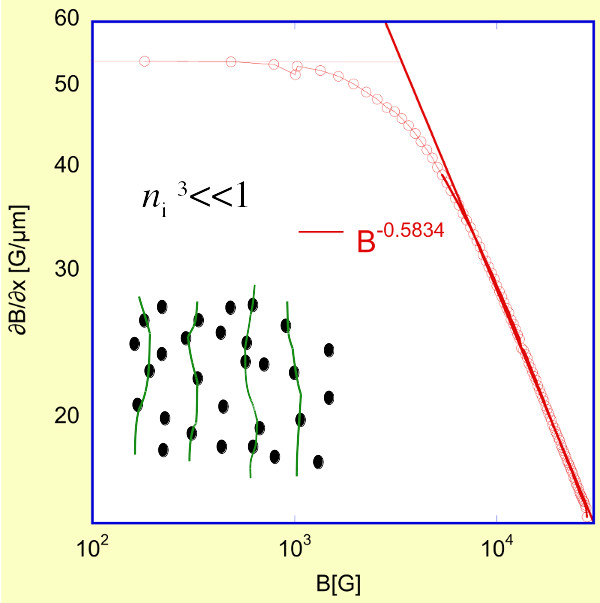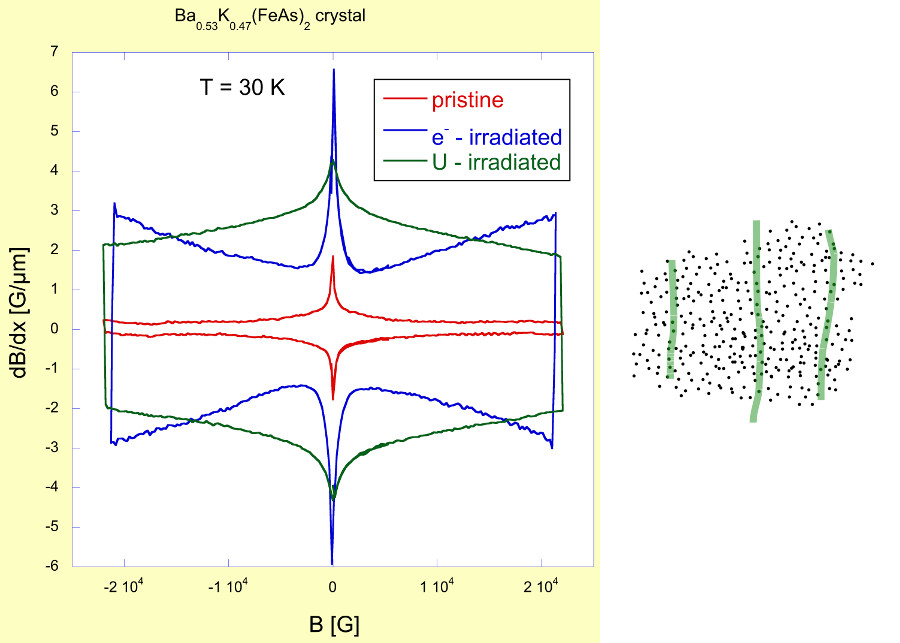Vortex matter in superconductors
The external magnetic field penetrates type II superconductor in the form of vortices, which in the absence of defects arrange themselves into triangular Abrikosov vortex lattice. In the presence of flowing currents, vortices may move, generating dissipation, and destroying zero-resistance state. The effect which prevents vortices from motion is the pinning of vortices by defects, which exist in the material, either in the form of intrinsic defects, or defects intentionally introduced by irradiation, doping of impurities, or other methods. The pinning enhances the critical current density, j, which is the parameter of type II superconductor most important for applications. Studying the effects of pinning is also interesting from more general point of view, important for the understanding of the dynamics of vortex matter in superconductor. Finally, as has been described recently, studies of the influence of defects on the vortex pinning may be useful for evaluation of the scattering rates [1]. The relation between scattering rates and superconducting transition temperature is directly relevant for testing of various mechanisms of pairing.
In general, there are two limiting regimes of vortex pinning, “strong” and “weak collective” pinning [2,3]. Strong pinning originates from large defects, such as nm-size heterogeneities, which "force" flux line to bend and intersect them, with total pinning force being the sum over all of defects. A signature of strong pinning is easily identified in the dependence of the critical current density, j, on the magnetic field B, by the presence of a plateau at low fields followed by a 1/√B dependence. On the other hand, weak collective pinning results from atomic-size defects, which enhance the critical current density by a constant contribution, evident at higher magnetic fields. The ground work on the subject of strong vortex pinning has been done by studies of the pinning in cuprates. One of the frequently cited works in this area is on the strong pinning present in thin films of YBCO, grown by PLD and investigated by our group in collaboration with the group from Laboratoire des Solides Irradies (LSI), Ecole Polytechnique (Palaiseau) [4]. Quantitative analysis of the j(B) dependence in the strong pinning regime allows determination of concentration of defects and of their size, which is helpful for the estimate of the scattering rates.
Recently, we undertook the studies of pinning regimes in pnictides, which belong to a family of iron-based superconductors [5]. In pristine BaK(FeAs)2 crystals the dominant is strong pinning regime, which is due to nanometer scale defects resulting from crystal inhomogenuities.

 Pristine samples show “star-shaped” magnetic hysteresis typical of strong vortex pinning regime [2,4]
Pristine samples show “star-shaped” magnetic hysteresis typical of strong vortex pinning regime [2,4]
Using electron beam irradiation it is possible to induce in these crystals “weak collective pinning”, resulting from point defects. On the other hand, heavy ion irradiation produces columnar defects, which result in “Bose glass” phase, with characteristic property of directional pinning. We have demonstrated that such directional pinning occurs in crystals which are irradiated by heavy ions in tilted (45° from c-axis) configuration. The process of columnar defect creation is particularly efficient at low temperatures.

Irradiation induced disorder tunes pinning regime from “strong” to “weak collective” or “Bose glass” variation without changing creep mechanism.
[1] C. J. van der Beek et al., Phys. Rev. B 81, 174517 (2010); C. J. van der Beek et al., Phys. Rev. Lett. 105, 267002 (2010).
[2] A. I. Larkin and Yu. Ovchinnikov, J. Low Temp. Phys. 21, 409 (1979).
[3] G. Blatter, et al., Rev. Mod. Phys. 66, 1125 (1994).
[4] Strong pinning in high-temperature superconducting films, C. J. van der Beek, M. Konczykowski, A. Abal’oshev, I. Abal’osheva, P. Gierlowski, S. J. Lewandowski, M. V. Indenbom, and S. Barbanera, Phys. Rev. B 66, 024523 (2002).
[5] Vortex pinning and creep regimes in BaK122 family of iron based superconductors in various disorder landscapes, M. Konczykowski, A. Abal’oshev, I. Abal’osheva, M.Tanatar, and R. Prozorov, International Workshop on Vortex Matter in Superconductors VORTEX 2015, El Escorial, 10-15 May, 2015.
